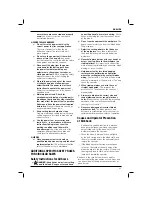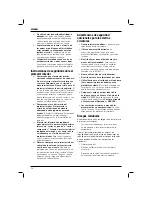
ENGLISH
48
clearance which increases the chance of
binding and increased loading.
5. RESTARTING A CUT WITH THE BLADE
TEETH JAMMED AGAINST THE MATERIAL
The saw should be brought up to full operating
speed before starting a cut or restarting a cut
after the unit has been stopped with the blade
in the kerf. Failure to do so can cause stalling
and kickback.
Any other conditions which could result in pinching,
binding, twisting, or misalignment of the blade could
cause kickback. Refer to the sections
Additional
Specific Safety Rules for Circular Saws
and
Blades
for procedures and techniques that will
minimize the occurrence of kickback.
Depth of Cut Adjustment (fi g. 6–8)
1. Raise the depth adjustment lever (q) to loosen.
2. To obtain the correct depth of cut, align the
appropriate mark on the depth adjustment strap
(s) with notch (r) on the upper blade guard.
3. Tighten the depth adjustment lever.
4. For the most efficient cutting action using
a carbide tipped saw blade, set the depth
adjustment so that about one half of a tooth
projects below the surface of the wood to be
cut.
5. A method of checking for the correct cutting
depth is shown in figure 8. Lay a piece of the
material you plan to cut along the side of the
blade, as shown in the figure, and observe how
much tooth projects beyond the material.
ADJUSTING DEPTH ADJUSTMENT LEVER (FIG. 7)
It may be desirable to adjust the depth adjustment
lever (q). It may loosen in time and hit the base plate
before tighten ing.
To Tighten the Lever:
1. Hold depth adjustment lever (q) and loosen the
locknut (t).
2. Adjust the depth adjustment lever by rotating it
in the desired direction about 1/8 of a revolution.
3. Retighten nut.
Bevel Angle Adjustment (fi g. 9)
The bevel angle adjustment mechanism (h) can be
adjusted between 0° and 57°.
To achieve better accuracy in cutting, use the
fine adjustment markings located on the pivot
bracket (v).
1. Raise the bevel adjustment lever (g) to loosen.
2. Tilt the base plate to the desired angle by
aligning the fine bevel pointer (u) with the
desired angle mark on the pivot bracket (v).
3. Lower the bevel adjustment lever to retighten.
Bevel Detent (fi g. 9)
The DWE575 and DWE576 are equipped with a
bevel detent feature. As you tilt the base plate you
will hear a click and feel the base plate stop at both
22.5 and 45 degrees. If either of these is the desired
angle, retighten the lever (g) by lowering it. If you
desire another angle, continue tilting the base plate
until the coarse bevel pointer (w) or the fine pointer
(u) aligns with the desired mark.
Cut Length Indicator (fi g. 10)
The markings on the side of the base plate show the
length of the slot being cut into the material at the
full depth of the cut. The markings are in increments
of 5 mm (1/5").
Mounting and Adjusting the Parallel
Fence (fi g. 11)
The parallel fence (x) is used for cutting parallel to
the edge of the workpiece.
MOUNTING
1. Slacken the parallel fence adjustment knob (y)
to allow the parallel fence to pass.
2. Insert the parallel fence (x) in the base plate (i) as
shown.
3. Tighten the parallel fence adjustment knob (y).
ADJUSTING
1. Slacken the fence adjustment knob (y) and set
the parallel fence (x) to the desired width.
The adjustment can be read on the parallel
fence scale.
2. Tighten the fence adjustment knob (y).
Mounting the Dust Extraction Spout
(fi g. 1, 6, 12)
Your DWE575/DWE576 circular saw is supplied with
a dust extraction spout.
TO INSTALL DUST EXTRACTION SPOUT
1. Fully loosen depth adjustment lever (q).
2. Place base plate (i) in the lowest position.
3. Align the left half of the dust extraction spout
(gg) over upper blade guard (m) as shown. Be
sure to insert the tab into the casting notch on
the tool. When installed correctly, it will snap fully
over the original depth of cut pointer.
Summary of Contents for DWE575
Page 1: ...www eu DWE575 DWE576 ...
Page 3: ...1 Figure 1 jj h d a e b c g k j i f m l DWE576 aa z DWE575 h ...
Page 4: ...2 d p c q Figure 4 Figure 6 s r q t Figure 3 Figure 5 l j n k o Figure 7 Figure 2 ...
Page 5: ...3 Figure 9 Figure 8 Figure 10 g h u v w DWE575 DWE576 ...
Page 6: ...4 Figure 11 Figure 12 bb dd cc Figure 13 gg gg gg x y i m ...
Page 7: ...5 Figure 15 ff bb 100 mm 20 mm Figure 14 ee ee bb DWE576 DWE576 ...
Page 8: ...6 Figure 17 Figure 16 ...
Page 9: ...7 Figure 18 Figure 20 ee ee 45 0 45 0 Figure 19 Figure 21 DWE576 DWE575 45 0 ...
Page 10: ...8 Figure 24 Figure 23 b f Figure 22 ...
Page 11: ...9 f Figure 28 Figure 25 Figure 27 Figure 26 hh Figure 29 g ii ...
Page 12: ...10 Figure 30 gg ...
Page 211: ...209 ...
















































